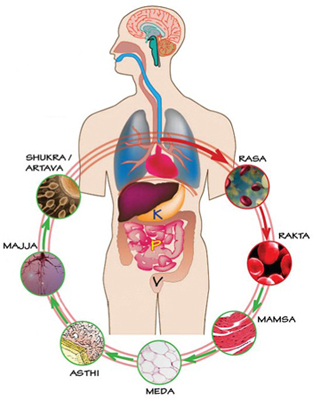What is Ayurveda and Its Importance in Maintaining Health?

Ayurveda is an ancient system of holistic healing through herbs. It is derived from two words, Ayu [Life] + Veda [Knowledge]. Ayurveda is Knowledge of Life.
WHAT IS LIFE (AYU)?
Life according to Ayurveda is a fusion of body, senses, mind and soul. Hence, the holistic healing is very important for health.

Life can be classified under 4 types in Ayurveda:
- Hitayu – beneficial life
- Ahita ayu – detrimental life
- Sukhayu – content state of health and mind
- Dukhayu – sorrowful state of health and mind.
AYURVEDA WORKS ON TWO PRINCIPLES
1. Dosha-Dhatu-Mala Principle:-
Dosha (Body humors):
It consists of three elemental substances or the three energies:
- Vata
- Pitta
- Kapha
Ayurveda’s main motive is to keep all the three doshas in a balanced state in order to keep the body free from any ailments.
Increase or decrease in these doshas gives rise to diseases.

Dhatu (Body Tissues):
Ayurveda has also described 7 tissues:
- Rasa [Plasma] – It nourishes the body.
- Rakta [Blood] – It aids in the oxygen and carbon dioxide exchange.
- Mamsa [Muscles] – It helps in everyday activities like walking, running etc.
- Meda [Fat] – It helps in lubricating joints and provides extra protection to tissues.
- Asthi [Bones] – It provides shape and support to the body.
- Majja [Bone marrow] – It lies in the bones and helps in the production of blood cells.
- Shukra [Semen] – It is the tissue which helps in reproduction.
Mala (Excretory Wastes):
- Urine
- Feces
- Sweat
2. Panchmahabhuta Principle:-
Ayurveda considers 5 elements known as panchamahabhutas:
- Space
- Air
- Fire
- Water
- Earth
And it is said that all existing physical creations are composed of these five elements. If these elements are in normal state only then body can function smoothly and is considered healthy.
AYURVEDA COMPRISES OF EIGHT BRANCHES
1. Kaya Chikitsa:-
Kaya is known as body and chikitsa refers to treatment. It is primarily concerned with the treatment of the body by taking medicines orally. It involves changes in lifestyle also.
2. Bala Chikitsa:-
Bala is referred to a child. This department deals with the pediatric group i.e. newborns up to 16 years of age.
3. Graha Chikitsa:-
This department is related to Psychiatric ailments. The ailments are treated by chanting different verses, hymns and by psychotherapy.
4. Shalakya Chikitsa:-
This department deals with diseases which affect the body parts above the shoulders. Mainly diseases of head, ear, nose and throat are dealt in this branch of Ayurveda.
5. Shalya Chikitsa:-
Shalya can be referred to as surgery. This department deals with surgical treatments.
6. Agad Chikitsa:-
It is also known as Toxicology. The harmful toxins released in the body after an animal bite or intake of a poison might prove to be fatal. So this branch is very important.
7. Jara Chikitsa:-
Jara can be referred to as old age. It can also be known as Geriatrics. This branch deals with treatment of ailments related to old age.
8. Vajikaran Chikitsa:-
It helps in treating disorders related to reproduction. It helps in treating infertility and prepare the couple for conception.
IMPORTANCE OF AYURVEDA IN MAINTAINING HEALTH
Importance of Ritucharya in Ayurveda:-
According to Ayurveda one year is divided in two kaals:-
1. Adaan Kaal (A Phase of Decreased Energy Level in the Body):-
- Shishir Ritu [Mid January – Mid March]
- Vasant Ritu [Mid March – Mid May]
- Greeshm Ritu [Mid May – Mid July]
2. Visarga Kaal (A Phase of Increased Energy Level in the Body):
- Varsha ritu [Mid July – Mid September]
- Sharad ritu [Mid September – Mid November]
- Hemant ritu [Mid November – Mid January]
Ritu Sandhi:-
The last seven days of previous season and the first seven days of a new season (14 days) are known as Ritu sandhi kaal. It is very important in Ayurveda for prevention of diseases.
During this inter seasonal period, the regime of the previous season should be slowly stopped and the regimen of the coming season should be slowly adopted. This sudden abandoning or adoption of a regime gives rise to ailments due to improper schedule.
IMPORTANCE OF DINACHARYA IN AYURVEDA
The daily regimen of a person is called Dinacharya. Din is referred to day and charya is referred to routine. According to Ayurveda, to have a healthy life, you should follow a proper schedule and it is extremely important to follow a routine in order to have an excellent health.
Dincharya is one of the most amazing things that Ayurveda offers to prevent ailments, keep your doshas balanced. A proper regimen is known to have a much stronger healing force than any medicine.
If we follow the basic Dincharya we can keep these doshas or energies balanced which will ward off many disorders. Dinacharya includes basic habits of morning hygiene and taking wholesome diet in a day.
IMPORTANCE OF RASAYANA AND VAJIKARAN IN AYURVEDA
Rasayana:-
Rasayana is a special branch of medicine which aids in the prevention of early ageing, provides longevity and prevents diseases. It is a rejuvenation therapy which not just cures a disease but also prevents it.
Rasayana chikitsa is the best form of treatment Ayurveda offers. It not only concentrates on the disease but also other aspects like patient’s age, lifestyle. It acts as an immunity booster also.
Vajikaran:-
When a person loses libido, Vajikaran is the treatment that is offered by Ayurveda to escalate libido. Vaji is referred to a horse, Vajikaran means to increase the sexual potency of a man like a horse.
The main objective of this treatment is to increase the sexual potency of a man and cure infertility. It boosts libido and sperm count. But these preparations shouldn’t be taken by a man who has no control over his senses as it could be harmful for the society.



